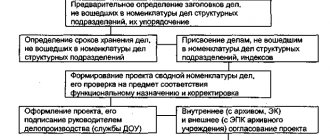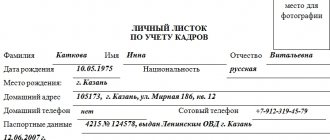What is the nomenclature of personnel service affairs?
The HR department of any modern company processes a huge number of different documents: local regulations, cards, work books, contracts. And of course, for their effective recording, systematization of document flow is necessary.
But even if a company is theoretically satisfied with managing the circulation of personnel documents outside of a systematic approach, in certain cases it will have to systematize it based on legal requirements.
The fact is that in accordance with paragraph 1 of Art. 17 of the Law “On Archival Affairs” dated October 22, 2004 No. 125-FZ, organizations must ensure the safety of documents classified as archival (subject to preservation due to their significance for the owner). These include almost all documentation used in personnel document flow. The safety of archival documents must be ensured by the employing company within the time limits established by law.
You will learn more about the periods established by law for storing archival documents in the article “What are the storage periods for documents according to the nomenclature of files?” .
At the same time, the method of fulfilling the requirements of Law No. 125-FZ depends on whether the organization is public or private:
- When optimizing document flow, government agencies must follow the rules established by the decision of the Rosarkhiv board of 02/06/2002 (hereinafter referred to as the Rosarkhiv rules).
- In general, private companies are not subject to this legal regulation (only if they use government documents). But in practice, many private firms still follow the relevant rules. This is due to the fact that the norms contained in them regulate in great detail and effectively the organization of document flow, the main element of which is precisely the nomenclature of cases.
What is she like? If we follow the definition of Rosarkhiv, the nomenclature of cases must be understood as a list of names of cases compiled in the established form, formed in the process of the organization’s document flow. In this case, affairs are understood as a category of documents of the same type used in the turnover of the company. If we talk about personnel services, these could be:
- orders;
- contracts;
- accounting documents;
- cards;
- work books, etc.
In accordance with the requirements of the Federal Archive, the nomenclature must indicate the storage periods for files. This allows the company to monitor whether the legal security of documents is ensured within the established time frames.
The nomenclature can also record other information used to improve the efficiency of document flow (for example, indexes of cases, the number of their volumes, service marks and notes). This is the benefit of nomenclature from the point of view of systematizing document management.
Case nomenclature options
In the practice of maintaining documentation, there are three options for the nomenclature of cases:
- Typical. It is being developed for several organizations operating in the same industry and having similar document flow.
- Approximate. It indicates an approximate list of cases that should be included in it.
- Individual. It is developed according to the specific document flow of a particular enterprise.
This classification was originally developed for state and municipal organizations. However, now it is being widely implemented by private companies. These developments have already been unified and tested over many years of use, so they are very convenient to use in the personnel services of private commercial organizations.
Ensuring the safety of documents: how the nomenclature can help
Ensuring the safety of personnel documents within the time limits established by law is one of the key tasks of a personnel officer. And the use of nomenclature can help solve it.
In order to store documents for a specified period, the personnel officer needs to determine this period (for each case) and compare it with the types of documents used.
The main regulatory legal acts that establish the storage periods for personnel documents can be called:
- list of standard documents approved by order of the Federal Archive of the Russian Federation dated December 20, 2019 No. 236;
- list of standard documents approved by the USSR Main Archive on August 15, 1988.
In particular, the rules establishing the storage periods for personnel documentation are contained in section 8 of the list approved by order No. 236, as well as section 6 of the list introduced by the USSR Main Archive.
The next task of the personnel officer is to conduct an examination of the value of the sources used in document flow. This procedure identifies documents that:
- must be archived for long-term storage;
- can be transferred for operational storage, and after the expiration of the period of their placement in the organization, they can be destroyed in the prescribed manner;
- may no longer be stored in the organization due to the expiration of their storage period (or due to the fact that they do not represent value for the company) and must be destroyed.
The HR officer will be able to successfully solve the problem under consideration precisely thanks to the nomenclature of cases, since its structure includes all the necessary information:
- lists of categories of documents whose safety must be ensured;
- their storage periods stipulated by law.
The nuances of compiling a nomenclature of personnel service affairs
We noted above that the rules of Rosarkhiv are in demand by private firms, although they are not mandatory for them. When compiling a list of cases, a personnel officer of a commercial organization may well rely on the standards approved by this department.
Thus, Rosarkhiv instructs government agencies (and actually recommends private firms) to draw up a nomenclature for the coming year. Preferably at the end of the current year, in order to put it into effect on January 1 of the next year. In turn, at the end of next year a new nomenclature needs to be approved. And so every year.
Let's see how this happens in practice. Let's agree that the company has just been founded and does not have a current nomenclature. What might be the algorithm of actions of a personnel officer to approve the list of cases in a newly formed organization?
The personnel officer needs to immediately prepare for the preparation of the future nomenclature immediately after starting work. This direction of his activity involves solving 2 main tasks:
- classification of documents used in circulation into categories, that is, the formation of cases;
- determination of storage periods for cases in accordance with the regulations specified above.
If the storage periods for a specific category of documents are not specified in Order No. 558, you should check whether they are recorded in the list of the Main Archive of the USSR. This sequence of reference to legal acts is due to the fact that the first source of law is newer and, in accordance with generally accepted legal practice, it should be applied first.
If none of the lists approved by law define the storage periods for certain files, you should consult on this matter (by making an official request) with the Federal Archive. It is not recommended to independently determine the storage period for documents.
As this work is carried out, the specialist must record the types of cases identified, as well as the periods for their storage provided by law in a special document. In fact, it will be the prototype of the future nomenclature, and therefore may completely coincide with it in structure.
The HR department is a structural unit of the organization. So the nomenclature of cases (and before it, a temporary document in which cases are classified) can be compiled according to the form from Appendix 8 to the rules of the Federal Archive, intended for registration of the nomenclature of cases in a particular structural unit of the company.
The main element of the form according to Appendix 8 is a table that reflects:
- case index;
- case title;
- number of storage units;
- storage periods and numbers of articles according to the list;
- notes on nomenclature.
Let's study the specifics of each of the columns of the table of the recommended form of nomenclature in more detail.
Structure of the nomenclature of the HR department
The structure of the nomenclature of affairs of the HR department in accordance with Appendix 8 to the rules of the Federal Archive is as follows:
- In the 1st column of the table, case indices are recorded. Typically they reflect:
- with which structural unit or area of activity of the company does this or that matter correlate?
- which serial number corresponds to a specific case.
- For example, if the index 01–02 is recorded in the nomenclature, this may mean that the case was compiled in division 01 (conditionally it can correspond to the personnel department) and is a group of documents of type 02 (conditionally they can correspond to fixed-term employment contracts).
- The 2nd column of the nomenclature in the form of Appendix 8 is the headings of the cases. The names of specific categories of documents or cases (orders, contracts, personal cards, etc.) are indicated here.
- The 3rd column of the nomenclature records the number of specific types of cases stored in the company. This column is filled in at the end of the calendar year, when the personnel officer will know exactly the number of cases recorded by the company.
- The 4th column records the storage period for each category of documents, and also provides links to articles of regulatory legal acts in which these periods are defined.
- In the 5th column, notes may be made regarding the use of documents related to a particular case. For example, reflecting the fact of seizure or destruction of certain documents.
Having generated a list of categories of personnel matters by the end of the year, the specialist can begin to officially approve this list in the form of a nomenclature of matters that will be used from January 1 of the next year.
Procedure for drawing up and approval
The first step is to analyze all documents, previous lists, documents that have arisen in the process of activity, the Charter, the collective agreement, the staffing table, regulations and other significant materials.
If the organization has divisions, then first they create their nomenclatures. These documents are then agreed upon by an expert commission (EC) or its own archival service .
After this, a consolidated nomenclature . It is also consistent with the EC and archive specialists.
The agreed list is approved by management and put into effect by order .
Learn the nuances of the HR department nomenclature from the video:
Didn't find the answer to your question? Find out how to solve exactly your problem - call right now:
It's fast and free!
We also recommend reading:
1 Comment
Hello! Orders on the tariffs of teaching staff at the beginning of the school year, which type of orders relate to personnel or to core activities?
Case index. The case index is indicated here.
The index consists of:
- The numbers are strictly subdivisions, which are indicated according to a special classifier. If it is missing, the type of activity of the organization is indicated.
- A serial number within the division or activity itself.
Let’s summarize this information and give an example for clarity. The index is divided into two parts. The first part is the structural unit. The second part is the serial number of the case. Example: 04-02; 05-01.
The following are:
- Case title. The names of the cases are written here, and it should be remembered that according to the instructions, the location of the cases is directly related to their importance. Simply put, in the first place is a document of an organizational and administrative nature, and a secondary place is occupied by planning and reporting documents. Moreover, inside the documents are arranged in order of decreasing shelf life.
- Number of storage units. Everything is simple here, the number of cases over the past year is indicated. In this regard, the columns are filled out at the end of the year when this figure is precisely known.
- Storage period and number of articles according to the list. Everything here corresponds to the name of the column, i.e. the storage time for files is set and an article in the list of standard management documents is indicated.
- Note. Additional notes relevant to the case are made here.
Approval of the nomenclature of personnel service cases
The nomenclature of the personnel department (a structural unit of the company) should be part of the consolidated nomenclature compiled for the organization as a whole. The consolidated nomenclature, in turn, can be formed on the basis of the form given in Appendix 7 to the rules of the Federal Archive.
Its structure almost completely coincides with that contained in Appendix 8. The table of this form contains the same columns as in the nomenclature for the structural unit.
The use and approval of a consolidated nomenclature in government agencies is an indispensable condition for legitimizing the nomenclature of departments (including the personnel service).
Let us agree that our private company also uses the rules of Rosarkhiv from the point of view of using the consolidated nomenclature.
If a private company decides to ensure maximum compliance of the nomenclature approval procedure with the standards set out in the rules of the Federal Archive, the procedure will be as follows.
The HR manager will need:
- finally formulate your nomenclature, carefully check the information reflected in the temporary accounting document according to the form from Appendix 8, and correct them if necessary;
- coordinate the formed nomenclature with the employee responsible for maintaining the archive (most likely, this will be the company’s document specialist), as well as the head of the personnel department;
- wait until the nomenclatures of other divisions of the company are agreed upon in a similar way.
The specialist responsible for compiling the consolidated nomenclature should:
- collect all the nomenclatures approved at the level of the company’s divisions, and then create, based on the data available in them, a consolidated nomenclature in the form approved in Appendix 7 to the rules of the Federal Archive;
- agree on the consolidated nomenclature with the document specialist;
- approve the consolidated nomenclature from the head of the company.
Coordination or approval of nomenclatures (personnel, other departments, consolidated) can be carried out by affixing the signatures of competent persons on them. But if approval of the document by the manager is required, it is better if a separate order is issued.
In government agencies, the consolidated nomenclature is consistent with departmental and internal expert commissions. In private companies, as a rule, there are no such divisions, so the text blocks of the form where the signatures of the certifying persons are placed can be modified by inserting blocks for approval by specific officials.
How to clarify the list of cases for next year
The list of cases is reviewed annually to ensure that the list of documents used remains up-to-date. The HR employee should analyze the nomenclature to identify outdated and unused sections and not add them for the next year. Not only entire sections can change, but also their names: for example, over the course of a year the name of the unit with which documents are exchanged has changed.
After all changes are taken into account, the procedure for approving the nomenclature for the next year takes place. If this requires the development of a separate order, then it must be issued in a short time.
https://www.youtube.com/watch?v=upload
A properly developed nomenclature becomes an indispensable assistant for managing and systematizing affairs in the personnel service; it indicates a professional approach to work. It makes it easy for new people to start working in the HR department, there is no confusion, and any document can be found very easily.
Results
The nomenclature of affairs of the HR department of an enterprise is a tool, the use of which, on the one hand, is necessary in order for the company to fulfill its statutory obligations, and on the other hand, it can significantly increase the efficiency of document flow.
The nomenclature for the coming year should be approved taking into account changes in the structure of cases occurring in the current year.
You can learn more about the specifics of compiling and using a list of cases in an enterprise from the article “How to create a list of cases in an organization?” .
Sources:
- Law “On Archival Affairs” dated October 22, 2004 No. 125-FZ
- order of Rosarkhiv dated December 20, 2019 No. 236
You can find more complete information on the topic in ConsultantPlus. Full and free access to the system for 2 days.
Changes in shelf life
Throughout the year, changes can be made to the nomenclature, for example, if the personnel service has created a new group of documents that was not previously classified. The procedure for making changes directly depends on the approval option: if this only requires the signature of the head of the personnel department, then no difficulties arise. In such a situation, employees often simply leave free lines in the nomenclature in advance to add new groups of documents to it.
If the nomenclature is approved by a separate order of the manager, then a new order must be issued, which specifies the new lines that must be entered. The number of cases section changes throughout the year, but such changes are not recorded by order.
If during the year any type of document goes out of circulation, a separate order about this is also not issued. However, the seized type of documentation is no longer included in the systematized list, and is not indicated in the nomenclature of the next year.
Order No. 236 of the Federal Archival Agency dated December 20, 2019 changed the storage periods for management, including personnel, documents. One of the innovations is a change in the storage periods for personnel documents. In particular, cases completed by office work before January 1, 2003 must be stored for 75 years, and files completed by office work after January 1, 2003 - 50 years.
Below are a number of documents with new retention periods.
Re-drafting, coordination and approval of the nomenclature of cases, as indicated above, is carried out when the functions and structure of the organization change. In addition, the inclusion of new case headings in sections of the nomenclature during the year does not require its re-coordination and approval. There is no formal basis for re-approval; however, due to significant changes in the name and storage periods of cases, it is recommended to approve a new nomenclature of cases.
https://www.youtube.com/watch?v=https:accounts.google.comServiceLogin
More on the topic MATERNAL CAPITAL if the second child died….
All news can be found here.
All articles on the application of labor legislation and personnel records management can be read here.









